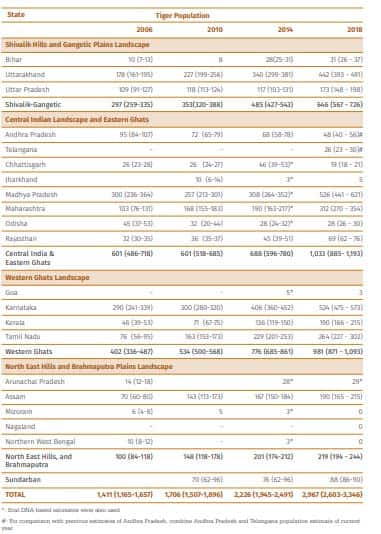India witnesses increase of 741 tigers within 4 years, nation houses 70% of global tiger population
In 2014, these five zones had 2,226 tigers which jumped to 2,967 in 2018.
- A day ahead of the Global Tiger Day 2020, Centre released the detailed report of the fourth All India Tiger Estimation- 2018.
- The number of tigers in India has increased by 741 within a span of four years, from 2014-18.
- In 2014, these five zones had 2,226 tigers which jumped to 2,967 in 2018.
A day ahead of the Global Tiger Day 2020, Union Environment Minister Prakash Javadekar on Tuesday released the detailed report of the fourth All India Tiger Estimation- 2018. The number of tigers in India has increased by 741 within a span of four years, from 2014-18.
According to the report, there are five zones in the country that works for the conservation of the tigers--Shivalik Hills and Gangetic Plains Landscape, Central Indian Landscape and eastern ghats, Western ghats Landscape, North East Hills and Brahmaputra plains Landscape and the Sunderbans. In 2014, these five zones had 2,226 tigers which jumped to 2,967 in 2018.
As per the report--Shivalik Hills and Gangetic Plains Landscape had 485 (2014) which increased to 646 (2018); Central Indian Landscape and eastern ghats had 688 (2014) which increased to 1033 (2018); Western ghats Landscape had 776 (2014) which increased to 981 (2018); North East Hills and Brahmaputra plains Landscape had 201 (2014) which increased to 219 (2018) and Sunderban had 76 (2014) which increased to 88 (2018).

The detailed report assesses the status of tigers in terms of spatial occupancy and density of individual populations across India. In addition to the summary report released by the Prime Minister Narendra Modi on the "Status of Tigers in India" in July 2019, this detailed report compares information obtained from the earlier three surveys (2006, 2010, and 2014) with data obtained from the 2018-19 survey to estimate population trends at country and landscape scales, patch colonization and extinction rates along with information on likely factors responsible for changes in tiger status at the fine spatial resolution of 100 km.
The report evaluates the status of habitat corridors connecting major tiger populations and highlights vulnerable areas that require conservation attention for each landscape. The report provides information on major carnivores and ungulates regarding their distribution and relative abundance.
During Global Tiger Day 2019, it was a proud moment for India as the PM declared to the world fulfilment of India’s resolve as it had doubled its tiger numbers four years in advance to the target year highlighting resolute action taken by all concerned. India’s tiger population now stands at 2967 which is 70 per cent of the global tiger population. A feather in India’s cap was added with the Guinness World Records recognizing the country’s efforts as the world largest camera trap survey of wildlife.
Javadekar on Tuesday said that despite several constraints such as less landmass, India has 80 per cent of bio-diversity because our country has a culture of saving and preserving nature, trees and its wildlife. Noting that wildlife is our natural wealth, he said, it is praiseworthy that India has 70 per cent of the world’s tiger population. He also said that India is tirelessly working with all 13 tiger range countries towards nurturing the tiger.
The minister announced that his ministry is working on a programme in which efforts would be made to provide water and fodder to animals in the forest itself to deal with the challenge of human-animal conflict which is causing deaths of animals. For this LIDAR based survey technology will be used for the first time. Lidar is a method for measuring distances by illuminating the target with laser light and measuring the reflection with a sensor.
Highlighting the keystone nature of the tiger, a poster on the presence of small cats was also released by the Environment Minister. With the presence of nearly 30 per cent of India’s tigers outside tiger reserves, India had embarked upon assessing management interventions through the globally developed Conservation Assured | Tiger Standards (CA|TS) framework, which will now be extended to all fifty tiger reserves across the country.
The detailed report of the 4th All India Tiger Estimation is unique in the following ways--Abundance index of co-predators and other species has been carried out which hitherto was restricted only to occupancy; Sex ratio of tigers in all camera trap sites has been carried out for the first time; Anthropogenic effects on tiger population have been elaborated in a detailed manner, and Tiger abundance within pockets in tiger reserves has been demonstrated for the first time.
Stay informed on all the latest news, real-time breaking news updates, and follow all the important headlines in india news and world News on Zee News.
)
